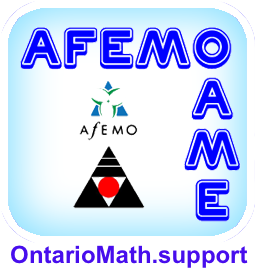President's Message - March 2024
From Slide Rulers To Calculators to Graphing Applications to ChatGTP

SANDRA JEAN PRICE
sandra.jean.price@oame.on.ca
When I was a student, calculators were only rarely allowed in most Grades 7 and 8 math classes. In high school, calculator use was much more accepted. I did, however, have a teacher who taught us how to use a slide rule. Graphing calculators were not a thing, and the early computer labs were for business students only. Years later, as I began teaching Grades 7 and 8, I taught with some teachers who believed that if students were allowed to use calculators, they would never learn how to do basic math calculations. Being a new teacher, I followed that lead until I began questioning assessments in which students clearly understood a concept, but made calculation errors. They were adamant that students needed to use their own brains, since “they will not always have a calculator with them.”
Fast forward to today. Most adults and many students do have a calculator with them in the form of an application on a phone. Students are taught how to use calculators in school. To clarify, basic computational skills are still taught, practised, and assessed, but calculators are used when needed as an appropriate tool when solving problems in many areas of mathematics when computation is just one small part of the goal of the activity. In fact, they are necessary tools, especially at the secondary level, since teachers no longer carry around books of trigonometry and logarithm tables. Students still use their number and operational sense to ensure that the answer the calculator produces is reasonable. After all, errors can still occur when entering the data.
But the conversation has now shifted to the use of AI in the math classroom. AIs can now solve equations. Does this mean that we need to stop teaching students how to solve equations? No, just as we did not stop teaching students how to do basic computations. But perhaps teachers need to rethink the types of questions that are being posed. If questions rarely reach beyond rote computation, then we need to dig deeper. Rote computations rarely lead to deep understanding of concepts and ability to solve complex problems using modelling and reasoning. If, as math educators, we can leverage AI instead of fighting it, it may be possible for students to eventually create complex mathematical models that were once out of reach. The challenge then becomes how to ensure that students are still “using their brains,” while taking advantage of what the technology can do for them (that perhaps doesn’t really “use their brains” terribly much).
All educators do need to work together to adapt and evolve. Some ways to begin to explore this technology, that is really in its infancy, include, but are not limited to: reading research on the topic, participating in a research study if one is available, contacting school board resource people or post-secondary educators, sharing ideas across panels, and trying out some of the AI applications. When teaching students about AI, educators need to ensure that students understand that AIs are not infallible and do make errors. They need to teach students how to use AI appropriately and ethically. After all, it is here to stay, and it has already proven to be a useful tool in many fields, including education.
Lately, I have been exploring a few different AIs in the creation of three-part math lessons. Some of the resulting lessons were very well explained and planned, while others were not. But there were some very interesting and effective activities within the lessons that I had never tried previously. I was able to input a grade-level text that the AI simplified to a lower reading level. This opens up a world where learning can be personalized and targeted, depending on student need. When trying things, however, there was also a lot of information that was not specifically based on the Ontario curriculum or assessment practices. To that end, OAME/AOEM has been exploring the creation of an Ontario- focused chatbot in the area of mathematics to support teachers with instructional pedagogy. While it is still in its early beta form, it is hoped that it will eventually be shared with our members.
Technology is experiencing exponential growth. It is up to us, as educators, to learn the new technology so that we can better prepare our students for jobs that may not even exist yet. This is a very lofty goal, but throughout the years, we have proven that we are ready to learn and can adapt to change. And that, in our world, is the first thing we need to teach.
Previous Message:
December 2023 Message
Next Message:
Down Memory Lane


















 Like us on FaceBook
Like us on FaceBook